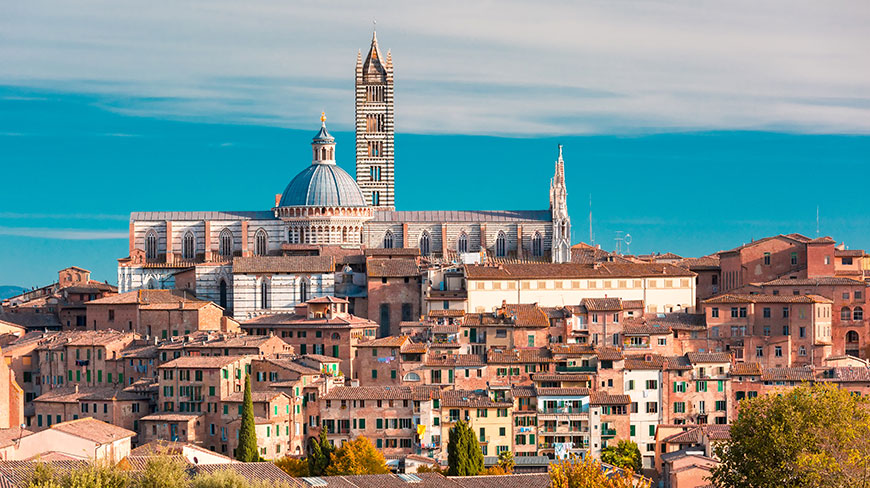Discover the Underground Orvieto Etruscan Caves of Italy
-
Central Italy's hidden gems in Umbria (Orvieto, Marmore Falls) and Tuscany (Saturnia Hot Springs) offer rich history and culture without the crowds of major cities.
-
Orvieto's subterranean city is a 2,500-year-old labyrinth of Etruscan and medieval tunnels, wells, and chambers, offering a unique glimpse into ancient life.
-
The underground tour is a must-do for history lovers, revealing architectural marvels like the Mill of Saint Clare and the intricate St. Patrick's Well.
-
Travel during spring or early fall is recommended for mild weather and smaller crowds when exploring the region.
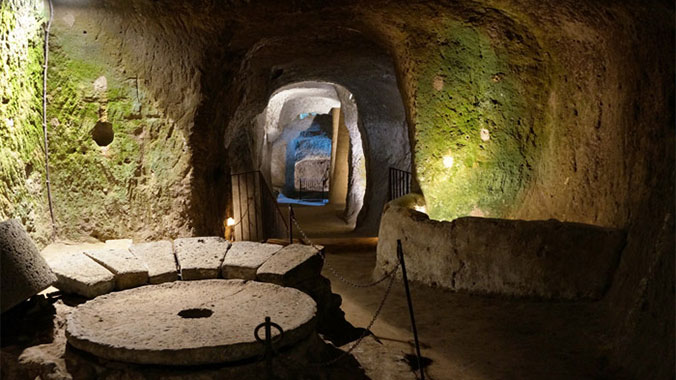
Central Italy is known for its slow pace, breathtaking views, and remarkable architecture. Tuscany and Umbria are two regions located in the center of Italy, and are home to world-renowned attractions like Michelangelo's David statue, the Duomo basilica, and the olive groves and vineyards of Chianti. While these destinations and attractions are well worth the visit, long lines and crowded spaces can be overwhelming. For those looking to immerse themselves in Italian culture, it’s time to explore off-the-beaten-path destinations in Italy.
In this guide, we’ll highlight the hidden gems in Tuscany, Italy, the secrets in Umbria, what to do in Orvieto, and more. As you prepare for your next adventure, use this list to find unfrequented landmarks in the hidden villages of Tuscany and Umbria to get a true Italian experience.

Orvieto Etruscan Caves
Believe it or not, beneath the town of Orvieto lies the elaborate maze of tunnels and caverns known as the Etruscan Caves. Over 2,500 years ago, the Etruscan civilization dug deep into the earth to supply their town with water. During the process, they began building a series of wells and tunnels that continued long after the Romans and into the Middle Ages. Today, there are over 1,200 tunnels in the Orvieto underground caves, along with galleries, grottoes, quarries, shelters and cellars. The construction of the Orvieto underground cave tunnels had no formal plans, creating a labyrinth of passages deep beneath the city.
For history lovers, a trip to the Orvieto underground caves is a must. As you wander the caverns and tunnels, you’ll get a glimpse into life several millennia ago, allowing you to witness architectural wonders and subterranean construction projects that stood the test of time.
Attractions of the Underground Orvieto Etruscan Caves of Italy
The Etruscan Caves of Orvieto are a fascinating historical and cultural attraction, having been used for centuries to access natural resources, particularly water. Throughout the Middle Ages, the labyrinth beneath the city of Orvieto continued to grow as generations continued to build an array of tunnel systems complete with millstones, storage structures, troughs and even an olive press station.
Before diving into some of the top attractions of the underground Italian caves in Orvieto, it’s important to understand the ancient Etruscan culture. The Etruscans were a civilization that thrived in Central Italy from around the ninth century B.C. to the first century B.C. They were skilled architects, engineers and urban planners, known for creating well-organized settlements with advanced infrastructure, including roads, irrigation systems, wells and sewers.
However, over the centuries, the Etruscan civilization slowly declined. The downfall started in the fifth century B.C. due to conflicts with neighboring civilizations, internal strife and, most notably, the expansion of Rome. By the first century B.C., the Etruscans were completely assimilated into the Roman Empire, with their culture and language gradually disappearing.
Now that you know who the Etruscans were and their many accomplishments, let’s explore some notable attractions they created in one of their cultural hubs, Orvieto, called Urbs Vetus and Velzna by the Etruscans. If their intricate architecture and infrastructure intrigue you, take a look at some of the top attractions in the caves of Italy built by the Etruscans in Orvieto:
-
The Quarry Well: Around 1527, Pope Clement VII ordered the construction of the Quarry Well, which is over 30 meters deep. This well was built on top of an existing well built 2,500 years prior by the Etruscans and was only used until the middle of the 17th century. As you make your way to the well, you will also come across hollows, which are rooms that were used as furnaces for ceramics.
-
The Well of Saint Patrick: Another famous well found in the caves is the Well of Saint Patrick, also ordered by Pope Clement VII around 1527. This well was constructed by Antonio da Sangallo the Younger and was intended as a water source should the city ever fall under attack. What makes this well an iconic attraction in the Orvieto underground caves is the double-helicoidal staircase that made it easy for animals to come and go unobstructed.
-
Underground streets: The Etruscans built an intricate network of streets below the city of Orvieto that made easy transportation possible. By excavating tuff (a type of volcanic rock), the Etruscans were able to build an entire city that was well fortified and organized. Through an underground tour of Orvieto, you can discover remnants of ancient houses, wells, workshops and escape routes used during times of conflict.
-
Architectural features: Throughout the caves beneath the city of Orvieto, you can marvel at the countless artistic and architectural features, including frescoes and carvings that adorn the walls. The artwork depicts scenes from everyday life, religious symbolism and mythological figures that defined Orvieto's culture and way of life.
-
Mill of Saint Clare: One of the most prominent attractions in Orvieto's underground is the Mill of Saint Clare, an ancient olive press that supplied the town with fresh oil. When touring the Mill of Saint Clare, you will find the large basalt millstones used for crushing olives as well as information about the history of the olive press from the Middle Ages to the 17th century.
-
Underground tours: You can partake in an underground tour of Orvieto that brings you through the caves. These tours are led by local experts and will provide keen insights into the history, architecture, art and culture that made these caves so important to the Etruscan civilization.
These are some of the top attractions you can find in these underground Italian caves. However, there’s much more to Orvieto — visitors can also enjoy a wide range of attractions and activities throughout the city.
More Nearby Attractions
The Etruscan Necropolis is a popular attraction. This cemetery, located on the outskirts of Orvieto, provides insights into Etruscan burial customs and rituals, allowing visitors to view carved tombs and decorative elements.
Another popular attraction is the Orvieto Duomo, where visitors can view the Chapel of San Brizio. The chapel contains one of the world’s most significant pieces of Italian Renaissance painting, with the fresco decorated by Benzolo Bozzoli, Luca Signorelli, and Beato Angelico. This chapel has a large layout that gave these artists free rein to paint a variety of important frescoes depicting various religious events, such as Christ sitting in judgment surrounded by angels, the apostles and the Virgin Mary.
As you can tell, Orvieto has a lot to offer its visitors. At Road Scholar, our experiential learning tours can bring you throughout the Umbria region to explore areas like the caves of Orvieto. Through our tours, you can enjoy spirited conversations with other group members while learning about the ancient Etruscan civilization responsible for the magnificent architectural and artistic features found in the city of Orvieto and beyond.
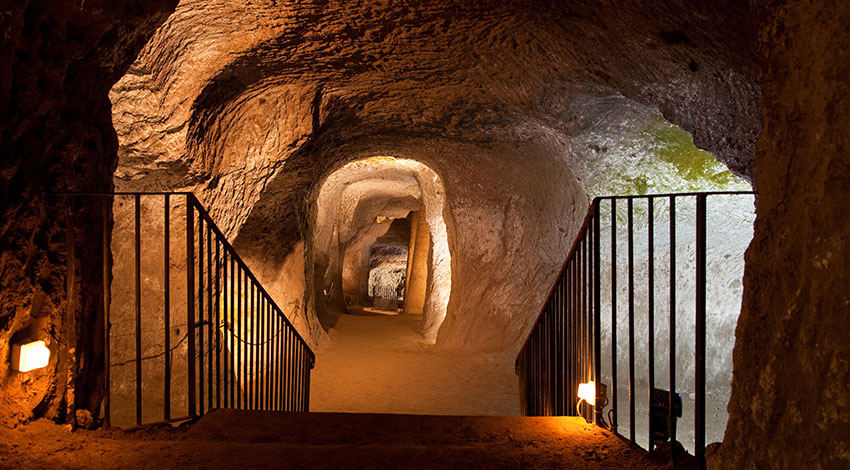
Frequently Asked Questions
What is the story of the Orvieto underground caves?
The fascinating story of the Orvieto underground city begins over 2,500 years ago when the Etruscans first settled atop this volcanic plateau.
The Etruscans, known for their engineering prowess, initially carved these passages into the soft tufa rock to reach the water table far below the surface. The volcanic rock proved ideal for excavation – soft enough to carve yet stable enough to create lasting structures.
During medieval times, the underground network expanded dramatically. Citizens continued the Etruscan tradition of digging, creating new tunnels and chambers for various purposes. Some areas served as wine cellars, taking advantage of the constant cool temperatures.
When armies approached Orvieto, residents could retreat into their subterranean city, complete with food storage, water sources and hidden escape routes.
The network also played a crucial role in daily medieval life. The Mill of Saint Clare, for instance, provided olive oil for the entire community, while other areas housed bakeries and grain storage facilities.
How long is the Orvieto underground tour?
A typical Orvieto underground tour lasts approximately 45 minutes to one hour, though the experience will feel much longer due to the wealth of history and fascinating stories you'll encounter. The standard guided tour covers about 500 meters of tunnels and chambers, representing just a fraction of the extensive 1,200-tunnel network that lies beneath the city.
Most tours begin at the tourist information center near the Duomo, where you'll receive a brief introduction to Etruscan and medieval history before descending into the underground world.
The pace of these tours is deliberately relaxed, allowing participants to fully absorb the historical significance of each area while having time to ask questions and take photographs.
Is the Orvieto underground city worth visiting?
Absolutely! The Orvieto Etruscan caves represent one of Italy's most remarkable archaeological treasures, offering a unique window into 2,500 years of continuous human habitation.
Unlike many tourist attractions that have been heavily reconstructed or modernized, these underground passages remain largely as they were carved centuries ago. Walking through these tunnels feels like stepping directly into history, with original Etruscan stonework, medieval frescoes, and ancient olive presses still visible in their original locations.
Can people with limited mobility visit the Orvieto Etruscan caves?
While the Orvieto underground caves present some accessibility challenges due to their ancient construction, many visitors with limited mobility can still enjoy significant portions of this remarkable attraction with proper planning and assistance.
The main entrance to the underground tours has been equipped with modern safety features, including improved lighting and handrails along key pathways. However, it's important to understand that you'll be navigating passages carved into rock over 2,000 years ago, which means uneven surfaces, low ceilings in some areas, and occasional steep sections are unavoidable.
Most tour operators can accommodate visitors who use walking aids like canes or walking sticks, and the slower pace of educational tours naturally allows for frequent rest stops. The constant cool temperature underground (around 14°C/57°F year-round) can actually be beneficial for visitors who find walking easier in cooler conditions.
What should seniors wear for comfort during the tour?
Comfortable clothing is essential for fully enjoying your underground adventure. The constant temperature in the Orvieto underground caves remains around 14°C (57°F) throughout the year, regardless of outside weather conditions, so layering is key to staying comfortable. Avoid sandals, flip-flops, or shoes with smooth soles that might cause slipping on wet stone surfaces.
Bring a light jacket or sweater, even during warm summer months. The underground temperature feels refreshing on hot days but can become chilly during longer tours, especially if you're wearing lightweight summer clothing above ground. A thin fleece or cardigan that's easy to put on or remove works perfectly.
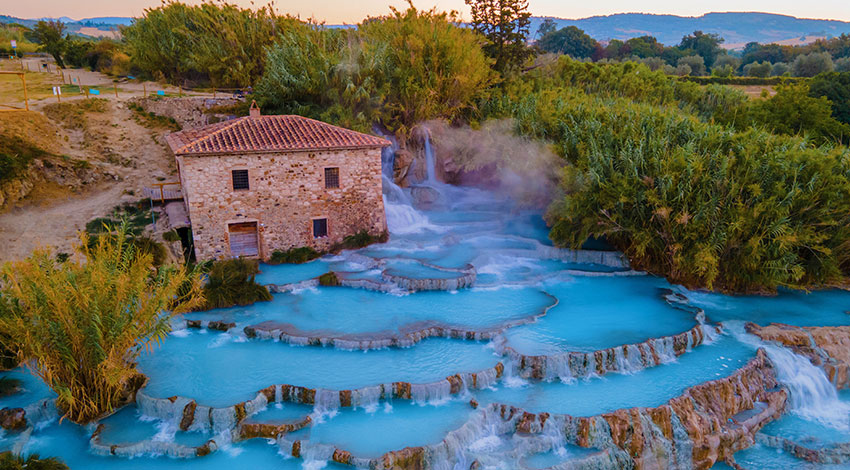
What to Do in Orvieto, Italy?
The ancient town of Orvieto is full of charm and stories worth exploring. With so much history, here’s a list of what to do in Orvieto, Italy:
-
Visit the Orvieto Cathedral, also known as the Duomo, and marvel at Gothic and Romanesque architecture, detailed mosaics and statues.
-
Check the time at Torre del Moro, a clock tower standing 47 meters high. You can even climb to the top for a stunning view of the city.
-
Relax at Rocca-Fortezza Albornoz, a public park housed in an ancient fortress that offers beautiful Umbrian scenery.
-
Explore Belvedere, an ancient Etruscan temple, and Pozzo di San Patrizio (St. Patrick’s Well), which has a set of twin staircases with 248 steps each going down into the well shaft.
But wait, there’s more. As mentioned, a trip to the city would not be complete without a tour of the Orvieto Etruscan Caves. Below, we’ll uncover the magic of these hidden gems.
Where is Orvieto, Italy?
Orvieto is a charming town located in the Umbria region of Central Italy, sitting atop a volcanic bluff in the Province of Terni. Approximately 75 miles north of Rome and 99 miles south of Florence, it is easily accessible by train from major Italian cities, making it an ideal destination for travelers.
Known for its rich history, Orvieto was originally called Velzna and was first inhabited by the Etruscans in the 9th century B.C. Due to its strategic location, the Etruscans built a formidable military town that was able to withstand Roman advances for years. However, in 264 B.C., the Romans eventually conquered the area.
Today, Orvieto is not only a historical gem but also a fantastic place to explore underground Italian caves. A tour of the city’s fascinating subterranean tunnels offers a unique glimpse into its past and provides visitors with a wealth of knowledge and unforgettable experiences.
Travel Tips for Visiting Orvieto
Planning your educational adventure to explore the underground Orvieto caves requires some thoughtful preparation to make the most of your learning experience. Whether you're traveling on one of our Italy family tours or joining other lifelong learners on a Mediterranean Italy exploration, these practical tips will help ensure your visit to this remarkable destination is both comfortable and enriching.
-
First, consider timing your visit during the shoulder seasons of spring or early fall when temperatures are mild and crowds are smaller.
-
When booking your accommodation, we recommend staying in Orvieto's historic center to fully immerse yourself in the medieval atmosphere. Many hotels offer stunning views of the surrounding Umbrian countryside, and you'll be within walking distance of both the underground attractions and the magnificent Duomo.
-
Transportation to Orvieto is remarkably convenient, with regular train service from Rome taking just over an hour.
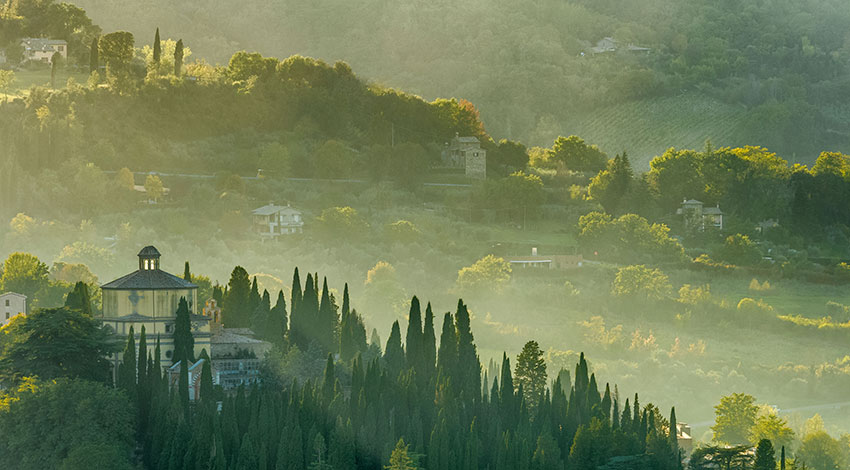
Hidden Gems in Tuscany, Italy
Tuscany is a region filled with history, culture, and cuisine. If you’re looking to explore off-the-beaten-path destinations in Tuscany, consider some of these items on this list:
-
Le Dieci Castella, which translates to “The Ten Castles,” is located in the city of Pescia, which is surrounded by ten hilltop villages that were once home to medieval castles. Escape the buzz of the cities and enjoy peace and calmness meandering down cobblestone streets, and maybe even sign up for a cooking class in Tuscany program.
-
Put yourself in the shoes of famous Renaissance artists by visiting San Miniato, another hilltop town with beautiful scenery overlooking the Arno River Valley.
-
For beach dwellers, you can’t go wrong with a stop at Porto Santo Stefano, a beach town located on the southern coast of Tuscany. Here, you can enjoy crystal blue waters, exciting boat rides, and seafood.
While this list is nonexhaustive, these are just some of the hidden gems in Tuscany, Italy, worth visiting.
The Secrets of Umbria and Tuscany
Umbria and Tuscany are two regions in central Italy known for their rich history dating back thousands of years. If you want to explore these regions without the crowds, consider these sites, landmarks, destinations, and attractions:
-
Marmore Falls: This secret of Umbria is well worth the hike. Marmore Falls is Italy’s second-tallest waterfall and it’s man-made. Created by the ancient Romans, Marmore Falls can be turned on and off. A visit to Marmore Falls is perfect for outdoor adventurers, as you can find hiking trails, caving, rafting, and canyoning tours.
-
Montone: Another hidden gem is the Umbrian village of Montone. Dubbed as “Museum Valley” for its breathtaking scenery and landscape, Montone is a perfectly preserved medieval town where visitors can marvel at centuries-old architecture, statues, and more.
-
Appennine Colossus at Villa Demidoff: Florence is known for its renowned works of art, such as the Uffizi Gallery, Giotto’s Bell Tower and Ponte Vecchio. However, a mere 30 minutes from the city center is a lush garden and beautiful villa that’s home to the Colosso dell’Appennino, a 16th-century statue created by Giambologna.
-
Lake Trasimeno: If you’re an avid birdwatcher, Lake Trasimeno is a must. As Umbria’s largest lake, bird lovers can find cormorants, wild ducks, and other feathered friends gliding along the lake. This secret spot is also great for swimming, recreation, and relaxing while taking in the views.
-
Saturnia Hot Springs: This hidden gem in Tuscany, Italy, is the perfect place to visit after a long day of exploring. The Saturnia Hot Springs is a little over two hours from both Rome and Florence, and boasts free natural thermal hot springs and waterfalls open year-round.
These are just some of the secrets of Umbria and Tuscany worth visiting on your trip to Italy. Explore more hidden gems, such as the Orvieto Etruscan Caves, below.
Visit Tuscany and Umbria with Road Scholar
At Road Scholar, we have a wide range of educational travel adventures to Tuscany and Umbria. From walking the hilltowns of Umbria to exploring its underground, our expert-led learning programs will immerse you in Italian culture.
Enroll now to walk down the Italian path less traveled!


